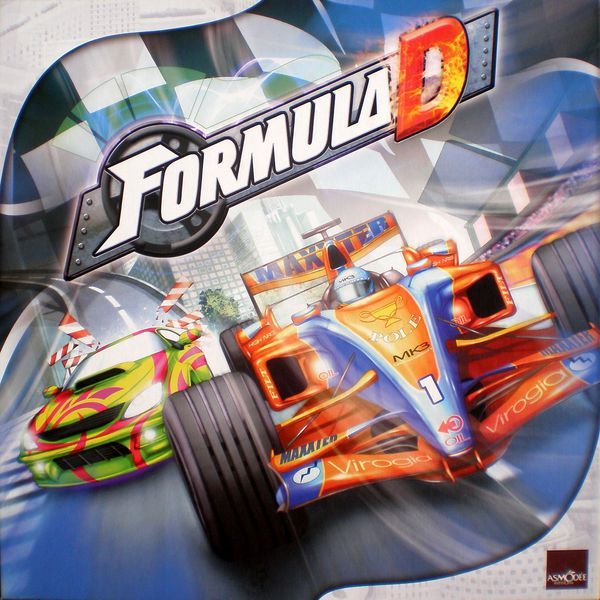Put the Pedal to the Metal in Formula D: A Racing Game of Dice and Gears

Hairpin turns, screeching tires, collisions, near misses, and a race to the finish!
Today we take a look at Formula D, the classic racing game that’s now over ten years old. Plenty of racing games have come out since then, so how does this one hold up?
Gameplay
The board features a three lane racetrack and each lane is divided into spaces. Each player starts by placing their car on one of the starting spaces.
Each car has six gears and each gear has a specific die associated with it. The number on the die you roll is how many spaces you will move — the higher the gear, the higher these numbers will be. First gear, for example, will have you moving one to two spaces while sixth gear will be between twenty-one and thirty. At the start of your turn you announce what gear you will be driving in. You may only move up or down one gear at a time. When moving down, however, you may skip one to three gears but you will take one point of wear for each gear you skip.
After announcing your gear, you roll the relevant die and move your car forward the necessary number of spaces. There are a few important concepts to remember when moving, though. You may only change lanes twice and you may not leave a lane and return to it unless you are you doing this zig-zag pattern to avoid another car. Also, every space in a corner has arrows which mark the legal paths you may take.
If you do not wish to use you the full movement from the die you rolled, you may stop early, taking one point of wear damage for each point of movement you did not use. Also, whenever you end your movement on a space next to or behind another car, you must roll a twenty sided die to see if there is a collision. If you roll a one to four, you take one point of wear damage.
Corners on the board are special. They are highlighted with a red line surrounding them. Each corner also has a number written next to it which is the number of times you must stop in that corner before leaving it. If you stop one less time than you're supposed to, you take one point of wear damage for each space your car overshot the corner. If you fail to make two or more required stops around a corner, you are eliminated from the game. If any car receives eighteen points of wear, they are also eliminated from the game. The first car to cross the finish line wins.

Review
Formula D looks great. Each player has a mini gear box to track what gear their car is currently in. These are fantastic set pieces that are fun to play with, handy for tracking information, and just really thematic. The board is large and inviting, with only a few components — making it feel very accessible.
There is a great interplay between push-your-luck and strategic planning. You need to play the odds to some extent to get an edge over your opponents, but you also want to avoid taking too much damage. If you push your luck early on the corners, you might not have enough wear to do the same near the end if you’re neck and neck with another player and close to the finish line. Selecting your gear requires you to not just consider this turn but at least one or two turns ahead and you need to consider where you are on the track and what’s coming up.
You are incentivized not to push your luck too much since you have to track your wear, but there is still a possibility that, with bad luck, you could get eliminated fairly early, and since game time is about an hour, this is problematic.
The game does offer choices to increase the complexity: adding laps and advanced rules such as weather conditions and having wear affect specific areas of the car. The newer edition of the game even comes with an additional mode that allows you to take on street racing that has its own challenges and map.
If you enjoy racing games, or dice games that add plenty of ways for you to affect the outcome, you should have a lot of fun with Formula D. It may have been around awhile, but it’s considered a classic for a reason.
Pros: The gear mechanics are great, thematic components, ability to adjust complexity
Cons: Players can be eliminated early






